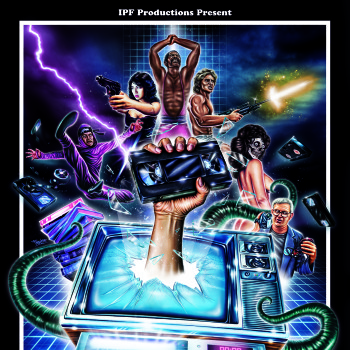“Rewind This” is a documentary about the golden age of VHS video tape back in the 1980s and ’90s. Josh Johnson,the creator of this movie about movies, explores the history of a low-res cassette that won out over a competing format that looked and sounded far better, and became an icon of the era.
Beyond mere nostalgia, the documentary explores the archives of movies which were released on this cheap, accessible format when it dominated the market – and which could now be lost entirely.

Rico Gagliano: So, anyone who grew up in that era remembers those big clunky VHS cassette tapes. This was the way we recorded TV shows at home… when we rented prerecorded movies from a video store they were on VHS… but there was another video format, called Beta, that looked and sounded better. Why did VHS tapes become the dominant video format?
Josh Johnson: Well, I mean there’s a number of factors that play into it, the largest thing being that you could fit more on a tape. And the average audience member that is not necessarily an audio/videophile is more interested in having the largest amount on the tape ,so they can record a full sports game or something like that, rather than having it in the best-looking or best-sounding condition.
Rico Gagliano: Sure, or you can see all of “Apocalypse Now” on one tape instead of divided across several.
Josh Johnson: Absolutely. I think that’s still sort of true to a certain extent now, in that a lot of streaming technology actually produces a lower grade picture and sound quality than what we have on Blu-Ray, but people for the most part are very content to consume things that way. For most people it’s really about convenience and access and affordability, and I think that was true then and it’s true now.
Rico Gagliano: That’s true. And as a Gen X’er I do, I have nostalgia for VHS tapes — I still have some VHS tapes with things I taped off of TV in the 1980s — But I have to say I don’t miss it as a format.
It’s just not… It was a very junky technology. The tapes wore out, they would break… but you’ve made a whole movie about people who collect movies in this format. You, yourself, are clearly into it. What is the appeal to you?
Josh Johnson: I think my interests are perhaps different from some of the subjects in the film. For me, it’s not so much a love of that particular format, or the video aesthetic — the way it looks — or the experience of watching something on a tape.
It’s really more of an archival value. There was so much released onto VHS, so much more than we’ll ever see on any future home video format, because the windows of those formats’ shelf life keeps becoming shorter and shorter.
Rico Gagliano: VHS was basically around for a long time.
Josh Johnson: Exactly. It was around for a long time, so everything came out, and as a result things that there would be no commercial reason to re-release, we’re not going to see those again. And so VHS is now the last stop for a huge chunk of our cultural history.
Rico Gagliano: These kind of B, C, and D-level movies that came out basically direct to video. There is, I have to say, an endless parade, in this movie, of clips from those movies. They are amazingly bad, a lot of them, and therefore hilarious. What is your favorite trashy video you came across while making this movie?
Josh Johnson: My favorite video that I’ve come across is a Canadian film called “Science Crazed.” And it was made in the late ’80s, shot in 16 mm, very inexpensively, and then never released for a number of years.
Then in 1991 a home video label in Canada decided to bring it out.
Josh Johnson: And the reason it was deemed to be unreleasable initially is that they didn’t really shoot enough footage to make a feature film. They basically had about 2/3 of what you would need to put together a feature, so the way they were able to get it up to an acceptable running time is by recycling a lot of the same moments, and the same shots, into new scenes and new contexts. So you actually see the same footage repeated over and over! You’ll have the same shot of a person walking down a hallway repeated ten minutes later.
And it’s endlessly fascinating to watch, for me, because it doesn’t really feel or look like a movie. It’s almost like an avant-garde theater piece or a gallery installation, but it wasn’t intended to be — it was intended to be a popular, fun horror film. And that kind of break down between what it was intended to be and what it actually is, is something that I find really valuable and really interesting.
I’ve watched it far more times than I would like to admit.
Rico Gagliano: These movies were able to make money because of the video store boom basically, right? It’s like people would just go in and there weren’t enough studio films on the shelves… and people would rent these low budget B, C, and D movies just because that’s what was there? Really?
Josh Johnson: Yeah. I think people didn’t understand necessarily that that’s what they were renting. You would look at a shelf, and there would be some studio films and there would be very low budget film, but they were both in the same video cassette boxes and they were sitting on the shelf right next to each other. A Warner Bros. title and something that was produced regionally in Nebraska more or less looked like they could be the same thing.
Rico Gagliano: It’s amazing. And therefore, of course, the covers become incredibly important, because you need to make those movies inside look like they are on par with the studio product. You talked to a lot of the artists who made these video boxes for these low-budget movies. Out of the millions of these things you must have looked at, what stands out in your mind?
Josh Johnson: Well, as far as just a really evocative piece of video box art, there’s a movie called “The Killing of Satan,” which is not an incredible film…
Rico Gagliano: What a surprise!
Josh Johnson: …It came out in 1983, but the box really does make it look like it’s going to be this guided tour of hell. And it’s so exciting to think about what that experience is going to be, and it’s not really at all what the film is. But that’s also kind of what makes special; that it evokes something inside your mind that is far broader and far greater and far bigger than what the film could ever be.
Rico Gagliano: I will admit that I worked at several video stores as a teenager, and the box that stood out for me was a horror movie called “Chopping Mall.”
Josh Johnson: Yeah, we actually were going to talk to the director of “Chopping Mall,” and he was shooting something while we were in Los Angeles. And he now basically shoots films in like four days.
Rico Gagliano: What?
Josh Johnson: Yeah. It’s really crazy. Usually for the direct-to-video market — I think he’s made a couple of things for the Sci-Fi channel — but he’s now become known as the guy that can make a film in a weekend. So that’s how he has stayed employed.
Rico Gagliano: See, without VHS tapes that guy would not have a career.
Josh Johnson: Actually — this would have been great to film too — in his kitchen when you go into his house, in all of his drawers, like you would ordinarily have cutlery? He has VHS tapes of his films that he’s made. He doesn’t put them on a shelf, he has them in his cabinets and drawers in his kitchen. Which is pretty great.


